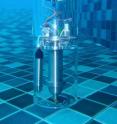Navy, Marine Corps tests autonomous zero-power bathythermograph sensors
Developed by the Naval Research Laboratory Bioenergy and Biofabrication Section in the Chemistry Division and the Physical Acoustics Branch of the Acoustic Division, the Zero Power Ballast Control (ZPBC) is a technology that relies on microbial energy harvesting developments to enable unsupervised underwater sensing with subsequent surfacing and reporting capabilities. With an ultimate goal of producing simple, small, power-efficient data harvesting nodes with variable buoyancy the device will be able to monitor ocean temperatures with a stay time ranging from weeks to months and eventually years, providing a longer term than other mechanisms such as the Expendable Bathythermograph (XBT).
"Preliminary trials were successful in many ways," said Dr. Justin Biffinger. "The device surfaced and submerged periodically as designed via hydrogen gas produced from the microbial inoculum and growth medium, proving the device generated gas in sufficient quantity to produce buoyancy."
During testing of two ZPBC systems, the rise and fall of the devices were supported by on-board pressure and temperature sensor data and direct observation. The bacterial fuel source (inoculated gas production vessel) was then attached and the two ZPBC devices were deployed in situ off a military pier in Sattahip, Thailand, and held in place by mooring lines for seven days.
Using a low-power (1 to 10 milliwatt [mW]) timer, or only the rate of microbial gas generation that requires zero power input, the device can be alternatively configured to surface "on-demand." Sensors (e.g., acoustic, magnetic) attached to the ZPBC could be used to detect and classify, monitor the rise to the surface, report using RF or other communication, then re-submerge and continue monitoring operations.
In the future, the ZPBC will provide input for robust modeling of ocean temperatures and other parameters. The ZPBC could also be used to provide in-water optical data to enhance models for underwater visibilities, laser penetration depths, diver and target vulnerability assessments, electro-optical system performance predictions, and refining numerical models.
Military utility and scientific applications include use in Intelligence Surveillance and Reconnaissance (ISR), Anti-Submarine Warfare (ASW), Mine Warfare (MIW), Naval Special Warfare (NSW), and Meteorology and Oceanography (METOC). Continued prototyping could include geo-referencing capabilities so that the device could be untethered in future tests.
The Office of Naval Research (ONR)/Naval Research Laboratory (NRL) Reserve Program, (Program 38) was tasked to conduct an experiment on ONR and NRL technologies which were incorporated into the U.S. Marine Corps Forces Pacific (MARFORPAC) Experimentation Center (MEC) Crimson Viper 2010 (CV10) Field Experiment.
Crimson Viper is a Thai-U.S. technology collaboration experimentation event jointly sponsored by the US Pacific Command (USPACOM) and the Royal Thai Defense Science and Technology Department (DSTD). The U.S. Marine Corps Forces Pacific (MARFORPAC) Experimentation Center (MEC), under the leadership of its Director, Mr. Shujie Chang, acts as the Thailand Science and Technology (S&T) executive agent for USPACOM.
Source: Naval Research Laboratory
Other sources
- U.S. Navy, Marine Corps tests autonomous zero-power bathythermograph sensorsfrom Science DailyMon, 27 Jun 2011, 19:30:44 UTC
- Navy, Marine Corps tests autonomous zero-power bathythermograph sensorsfrom PhysorgMon, 27 Jun 2011, 14:31:03 UTC
